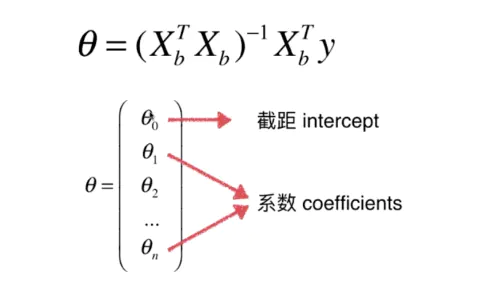1 概述
一元线性回归只能拟合
y
=
a
x
+
b
y=ax+b
y=ax+b,或者说只能拟合直线。
其实对于多元线性回归来说,
x
2
,
x
3
.
.
.
x_2,x_3...
x2,x3...是不同于
x
1
=
x
x_1=x
x1=x的另一个特征,方程可表示为:
y
=
θ
1
x
1
+
θ
2
x
2
+
.
.
.
+
θ
n
x
n
+
θ
0
y=\theta _{1}x_1+\theta _{2}x_2+...+\theta _{n}x_n+\theta _{0}
y=θ1x1+θ2x2+...+θnxn+θ0
x
1
,
x
2
.
.
.
x_1,x_2...
x1,x2...是因变量(特征),
θ
1
,
θ
2
.
.
.
\theta _{1},\theta _{2}...
θ1,θ2...是系数,
θ
0
\theta _{0}
θ0是截距。
多元线性回归可以用特征方程去求解。

代码实现:
import numpy as np
class LinearRegression():
def __init__(self):
self._theta = None
self.coef = None
self.interception = None
def fit(self, X_train, y_train):
X_b = np.hstack([np.ones((X_train.shape[0] ,1)), X_train])
self._theta = np.linalg.inv(X_b.T.dot(X_b)).dot(X_b.T).dot(y_train)
self.coef = self._theta[1:]
self.interception = self._theta[0]
return self
def predict(self, X_test):
X_b = np.hstack([np.ones((X_test.shape[0] ,1)), X_test])
return X_b.dot(self._theta)
2 多项式线性回归
多项式线性回归是多元线性回归中比较特殊的一类,只有一个因变量
x
x
x,其它的特征是
x
x
x的几次方,比如
y
=
a
x
2
+
b
x
+
c
y=ax^2+bx+c
y=ax2+bx+c或者是更高次数的方程:
y
=
θ
1
x
+
θ
2
x
2
+
.
.
.
+
θ
n
x
n
+
θ
0
y=\theta _{1}x+\theta _{2}x^2+...+\theta _{n}x^n+\theta _{0}
y=θ1x+θ2x2+...+θnxn+θ0
以 y = a x 2 + b x + c y=ax^2+bx+c y=ax2+bx+c为例:
import numpy as np
from matplotlib import pyplot as plt
x = np.random.uniform(-3, 3, size=100)
x = np.sort(x)
X = x.reshape(-1, 1)
# X.shape (100, 1)
y = 0.5*x**2 + x + 2 + np.random.normal(0, 1, 100)
# y.shape (100,)
plt.scatter(X, y)

这是一个抛物线,如果再用一元线性回归去拟合,就是下面的样子,可以发现误差时非常大的:

一元线性回归只有一个特征
x
x
x,多项式回归则是添加新的特征(
x
2
,
x
3
.
.
.
x^2, x^3...
x2,x3...),这里我只需要添加
x
x
x的平方,来拟合一个抛物线。
3.1 使用np.hstack函数
# 使用np.hstack函数,将两个特征在水平方向上拼接
X2 = np.hstack([X, X**2]) # 拼接
# X2.shape (100, 2)
'''
注: np.vstack() :在竖直方向上堆叠
np.hstack() :在水平方向上拼接
'''
from sklearn.linear_model import LinearRegression
lin_reg = LinearRegression()
lin_reg.fit(X2, y)
y_predict = lin_reg.predict(X2)
print(lin_reg.coef_) # 系数 a, b
# array([1.04078131, 0.54484198])
print(lin_reg.intercept_) # 截距 c
# 1.9212545662064286
# 绘制一下图像
plt.scatter(X, y, color="b")
plt.plot(x, y_predict, color="r")

3.2 PolynomialFeatures
from sklearn.preprocessing import PolynomialFeatures
# 构造多项式,如果只有一个x,degree=2,则为[1, x, x^2],其中1代表截距列
poly = PolynomialFeatures(degree=2)
poly.fit(X)
X3 = poly.transform(X) # 构建X
X3.shape # (100,3)
同样的,用LinearRegression()拟合。
lin_reg = LinearRegression()
lin_reg.fit(X3, y)
y_predict = lin_reg.predict(X3)
3.3 pipeline
from sklearn.pipeline import Pipeline
from sklearn.preprocessing import StandardScaler
# 三合一
poly_reg = Pipeline([
("ploy", PolynomialFeatures(degree=2)), # 生成多项式特征
("std_scaler", StandardScaler()), # 数据归一化
("lin_reg", LinearRegression()) # 进行线性回归
])
poly_reg.fit(X, y)
y_predict = poly_reg.predict(X)
plt.scatter(X, y, color="b")
plt.plot(x, y_predict, color="r")























 1303
1303











 被折叠的 条评论
为什么被折叠?
被折叠的 条评论
为什么被折叠?








